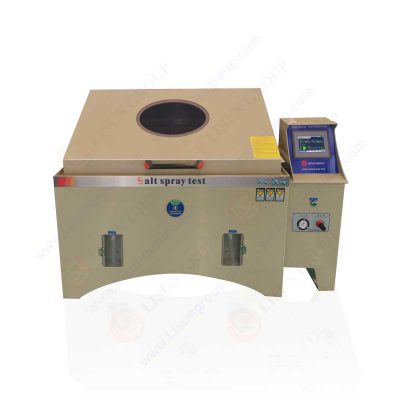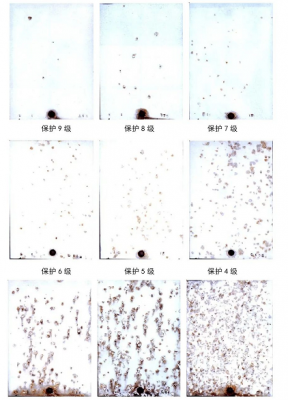Salt spray test is a kind of environmental reliability test, mainly used to test the corrosion resistance of metal materials of lamps. In order to verify whether the metal parts on the product will corrode when exposed to the atmosphere or other environments, the product can be placed in the use environment for a long enough time, such as a product life cycle. This is time-consuming and labor-intensive. In practice, it is rarely used, so a convenient method is needed to evaluate the corrosion resistance of the product. It can spray mist-like corrosive liquid on the metal material of the lamp, thereby simulating the environmental corrosion of the metal material of the lamp. Its biggest advantage is that the corrosive environment can be controlled, the environment reproducibility is excellent, the test time is significantly shortened, and a lot of manpower, financial and material resources are saved.

YWXQ-010 Salt Spray Test Chamber
Standard:
The salt fog test chamber meets the following standards: IEC60068-2-11 (GB/T2423.17), GB/T10125, GB/T1771, ISO9227, ASTM-B117, GB/T2423-18, QBT3826, QBT3827, IEC 60068-2-52, ASTM-B368, MIL-STD-202, EIA-364-26, GJB150, DIN50021-75, ISO3768, ISO 9227, 3769, 3770; CNS 3627, 3885, 4159, 7669 etc.
Which products need to do salt spray test?

Metal products need to do salt spry test
Metals and their alloys, anodic oxide films, organic coatings, such as paint, varnish, powder coating, anti-rust oil, etc.
Metal coatings as below: electroplating, electroless plating, ion plating, sputtering, hot dip plating, chemical vapor deposition, etc. The commonly used electroplating layers include zinc plating, copper plating, nickel plating, chromium plating, tin plating, brass plating, and pewter, etc.
The experimental method can be divided into four kinds of neutral salt spray test, acetic acid salt spray test, copper salt accelerated acetic acid salt spray test, and alternating salt spray test. The current mainstream test method in the market is the neutral salt spray test.
The neutral salt spray test (NSS test) is one of the earliest accelerated corrosion test methods with the widest application field. It uses 5% sodium chloride salt aqueous solution, the pH value of the solution is adjusted in the neutral range (6-7) as the spray solution. The test temperature is 35℃, and the sedimentation rate of the salt spray is required to be between 1~2ml/80cm².h.
The acetic acid salt spray test (ASS test) is developed on the basis of the neutral salt spray test. It is to add some glacial acetic acid to 5% sodium chloride solution to reduce the pH value of the solution to about 3, the solution becomes acidic, and the salt mist formed in the end also changes from neutral salt mist to acid. Its corrosion rate is about 3 times faster than the NSS test.
KOWINTEST copper salt accelerated acetic acid salt spray test (CASS test) is a kind of rapid salt spray corrosion test recently developed abroad. The test temperature is 50℃. A small amount of copper salt—copper chloride is added to the salt solution to strongly induce corrosion. Its corrosion rate is approximately 8 times that of the NSS test.
The alternating salt spray test is a comprehensive salt spray test, which is actually a neutral salt spray test plus a constant damp heat test. It is mainly used for cavity-type complete products. Through the penetration of the wet environment, the salt spray corrosion is not only generated on the surface of the product, but also inside the product. It is to alternately switch the product under two environmental conditions of salt spray and damp heat, and finally evaluate the electrical performance of the whole product.
When doing the salt spray test, there is basically a set of test standards and test rating judgments. The corrosion situation of the salt spray test is mainly judged by four methods, the rating judgment method, the weighing judgment method, the corrosive appearance judgment method and the corrosion data statistical analysis method.
Salt spray test rating method
1. Rating judgment method
The percentage of the ratio of the corrosion area to the total area is divided into several levels according to a certain method, and a certain level is used as the basis for qualification judgment, which is suitable for the evaluation of flat samples.
2. Weighing Judgment Method
The corrosion resistance quality of the sample is evaluated by calculating the weight loss (or weight gain) of the sample before and after the corrosion test, which is suitable for assessing the corrosion resistance quality of a certain metal.
3. Judging the appearance of corrosives
It is a qualitative determination method. It determines whether the product has corrosion after the salt spray corrosion test to determine the sample. This method is mostly used in general product standards.
4. Statistical analysis method of corrosion data
It is mainly used to analyze and count the corrosion situation, rather than to determine the quality of a specific product.
The salt spray test standard is divided into ten levels:

Ten levels of the salt spray test
Grade 10: No defect area, appearance rating A, no change in the appearance of the sample surface;
Grade 9: The defect area accounts for no more than 0.1%, the appearance rating is B, and the sample surface has slight to moderate discoloration;
Grade 8: The defect area accounts for between 0.1% and 0.25%, and the appearance rating is C. The surface of the sample is severely discolored or has very slight corrosion;
Level 7: The defect area accounts for 0.25% to 0.5%, and the appearance is graded D. The surface of the sample is severely lost with very slight corrosion products;
Grade 6: The defect area accounts for 0.5% to 1.0%, the appearance rating is E, the surface of the sample is severely lost, or there is a thin layer of corrosion products or pitting on the partial surface of the sample;
Grade 5: The defect area accounts for 1.0% to 2.5%, and the appearance rating is F. There are corrosion products or pitting corrosion on the surface of the sample, and one of them is distributed on the entire surface of the sample;
Level 4: The defect area accounts for 2.5% to 5%, and the appearance is graded G. There is a thick layer of corrosion product or pitting on the surface of the sample;
Level 3: The defect area accounts for 5% to 10%, and the appearance rating is H. There is a very thick corrosion product layer or pitting corrosion on the surface of the sample, and there is deep pitting corrosion;
Level 2: The defect area accounts for 10% to 25%, and the appearance is rated I. The sample has corrosion of the base metal;
Level 1: The defect area accounts for 25% to 50%, which is a serious corrosion phenomenon.
Lisun Instruments Limited was found by LISUN GROUP in 2003. LISUN quality system has been strictly certified by ISO9001:2015. As a CIE Membership, LISUN products are designed based on CIE, IEC and other international or national standards. All products passed CE certificate and authenticated by the third party lab.
Our main products are Goniophotometer, Integrating Sphere, Spectroradiometer, Surge Generator, ESD Simulator, EMI Receiver, EMC Test Equipment, Electrical Safety Tester, Environmental Chamber, Temperature Chamber, Climate Chamber, Thermal Chamber, Salt Spray Test, Dust Test Chamber, Waterproof Test, RoHS Test (EDXRF), Glow Wire Test and Needle Flame Test.
Please feel free to contact us if you need any support.
Tech Dep: Service@Lisungroup.com, Cell/WhatsApp:+8615317907381
Sales Dep: Sales@Lisungroup.com, Cell/WhatsApp:+8618917996096
Your email address will not be published. Required fields are marked *